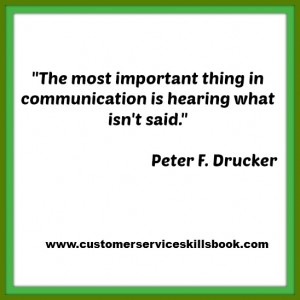Delivering Customer Service to a Diverse Customer Base
Personal awareness on the part of customer service representatives is the first step in delivering customer service to a diverse customer base.
The word diversity encompasses a broad range of differences. Many people only associate the term diversity with cultural diversity, which has to do with the differences between groups of people, depending on their country of origin, backgrounds, and beliefs. They fail to recognize that diversity is not just cultural. Certainly, diversity occurs within each cultural group; however, many other characteristics are involved. For example, within a group of Japanese people are subgroups such as different generations, males, females, children, athletes, thin people, gay or lesbian people, Buddhists, Christians, grandparents, married and single people, to mention just a few of the possible diverse characteristics, beliefs, and values.
Diversity is not a simple matter, yet it is not difficult to deal with. Start your journey to a better understanding of diversity by being fair to all people and keeping an open mind when interacting with them. In fact, when you look more closely at and think about, diversity it provides wonderful opportunities because people from varying groups and geographic locations bring with them special knowledge, experience, and value. This is because even though people may have differences or potentially look different, they also have many traits in common. Their similarities form a solid basis for successful interpersonal relationships if you are knowledgeable and think of people as individuals; you can then capitalize on their uniqueness. If you cannot think of the person instead of the group, you may stereotype people—lump them together and treat them all the same. This is a recipe for interpersonal disaster, service breakdown and organizational failure.
Some diversity factors that make people different are innate and they are born with them, such as height, weight, hair color, gender, skin color, physical and mental condition, and sibling birth order. All these factors contribute to our uniqueness and help or inhibit us throughout our lives, depending on the perceptions we and others have. Other factors that make us unique are learned or gained through our environment and our life experiences. Examples of these factors include religion, values, beliefs, economic level, lifestyle choices, profession, marital status, education, and political affiliation. These factors are often used to assign people to categories. Caution must be used when considering any of these characteristics since grouping people can lead to stereotyping and possible discrimination.
The bottom line is that all of these factors affect each customer encounter. Your awareness of differences and of your own preferences is crucial in determining the success you will have in each instance.
To learn more about providing quality service to all your customers, explore Please Every Customer: Delivering Stellar Customer Service Across Cultures and other current books on the topic of the Delivering Customer Service to a Diverse Customer Base.
About Robert W. Lucas
Bob Lucas has been a trainer, presenter, customer service expert, and adult educator for over four decades. He has written hundreds of articles on training, writing, self-publishing, and workplace learning skills and issues. He is also an award-winning author who has written thirty-seven books on topics such as, writing, relationships, customer service, brain-based learning, and creative training strategies, interpersonal communication, diversity, and supervisory skills. Additionally, he has contributed articles, chapters, and activities to eighteen compilation books. Bob retired from the U.S. Marine Corps in 1991 after twenty-two years of active and reserve service.
Make Money Writing Books: Proven Profit Making Strategies for Authors by Robert W. Lucas at Amazon.com.
The key to successfully making money as an author and/or self-publisher is to brand yourself and your company and to make yourself and your book(s) a household name. Part of this is face-to-face interaction with people at trade shows, library events, book readings, book store signings, blogging or guest blogging on a topic related to their book(s). Another strategy involves writing articles and other materials that show up online and are found when people search for a given topic related to a topic about which the author has written.
If you need help building an author platform, branding yourself and your book(s) or generating recognition for what you do, Make Money Writing Books will help. Bob’s popular book addresses a multitude of ideas and strategies that you can use to help sell more books and create residual and passive income streams. The tips outlined in the book are focused to help authors but apply to virtually any professional trying to increase personal and product recognition and visibility.








